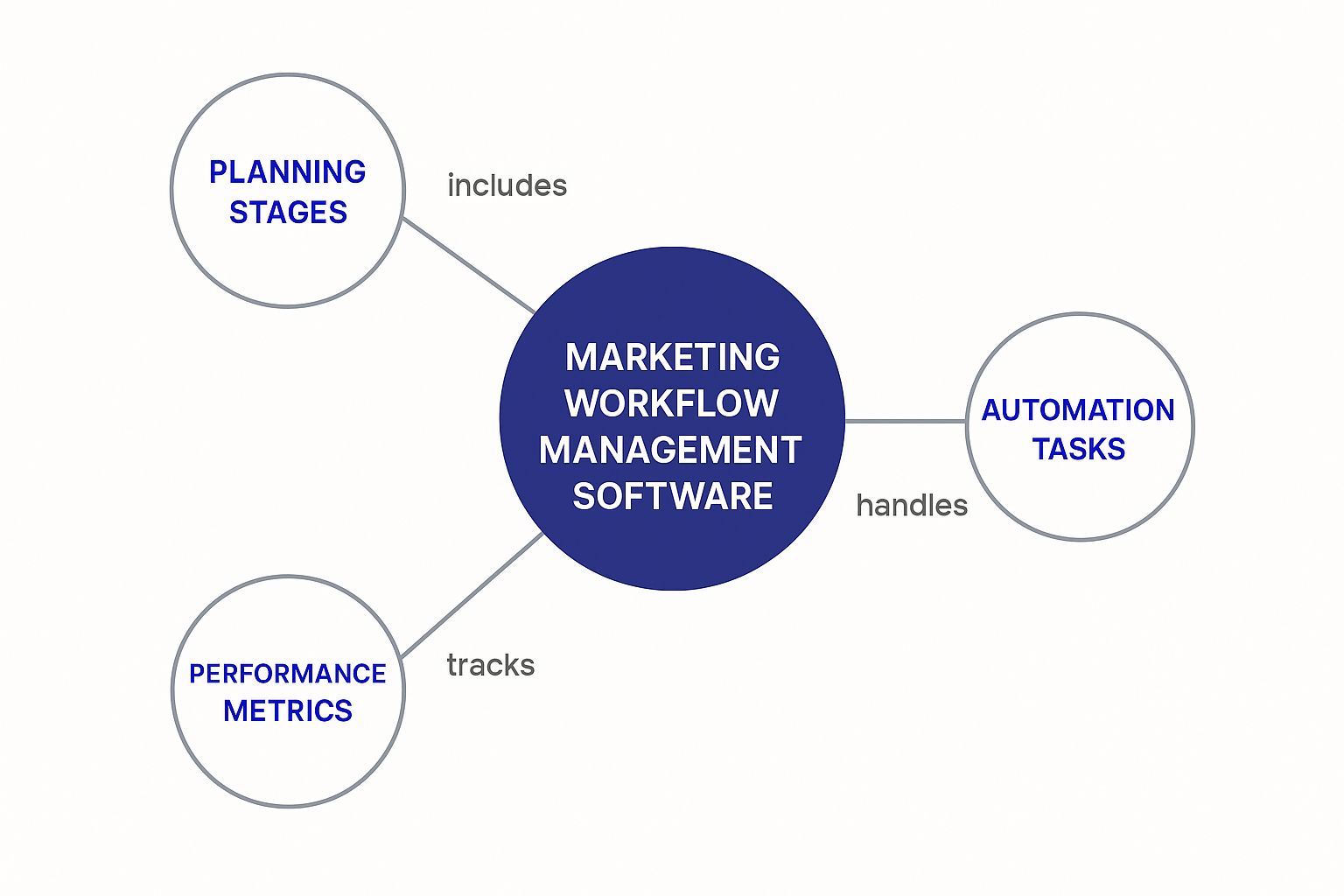Ever tried conducting a symphony orchestra where every musician plays at their own tempo? That's what modern marketing feels like without the right processes in place. A whole lot of noise, but no music.
Marketing workflow management software is the conductor that brings it all together. It’s the central system that organizes, automates, and directs every single marketing activity, turning chaos into a perfectly harmonized performance.
The Conductor of Your Marketing Orchestra
At its heart, marketing workflow management software is the central nervous system for your campaigns. It’s designed to transform your operations from a tangled mess of spreadsheets, email chains, and frantic manual follow-ups into a smooth, predictable process.
This isn't just another project management tool with a marketing label slapped on it. It’s a dedicated platform, built from the ground up to handle the unique, fast-paced demands that only marketing teams truly understand.
Think of it like building a house. You could show up with a pile of lumber and hope for the best, but we all know how that ends. Or, you could use a detailed blueprint. With a blueprint, everyone knows their role, tasks are done in the right order, and the project moves forward seamlessly. This software is that essential blueprint for every single campaign you run.
From Marketing Chaos to Workflow Clarity
The difference this kind of software makes is night and day. It takes all the disconnected parts of your marketing efforts and pulls them into one clear, manageable picture. The table below shows just how it turns common frustrations into streamlined solutions.
| The Common Marketing Problem | How Workflow Software Solves It |
|---|---|
| Disconnected tools (email, Slack, spreadsheets) create confusion and lost information. | A single source of truth where all communication, files, and tasks live. |
| Endless back-and-forth for approvals leads to major bottlenecks and delays. | Automated approval sequences that route content to the right people at the right time. |
| Inconsistent processes across the team mean quality and deadlines are a gamble. | Standardized templates and workflows for repeatable tasks like blog posts or social campaigns. |
| Lack of visibility into project status causes constant "just checking in" interruptions. | Real-time dashboards and visual timelines that show exactly where every project stands. |
| Manual hand-offs between team members are slow and prone to human error. | Automated task assignments that notify the next person in line the moment their part is ready. |
By addressing these core pain points, the software doesn't just make your team's life easier—it makes your marketing more effective. It frees everyone from administrative busywork to focus on what they do best: creating great work that drives results.
Centralizing Your Marketing Universe
One of the biggest wins is creating a single source of truth for your entire team. It centralizes everything, from the first brainstorm to the final performance report.
Here’s a look at the key activities it brings together:
- Content Ideation and Creation: Track every idea from spark to polished draft, all in one collaborative space.
- Approval Processes: Set up clear, automated steps for getting content reviewed. No more chasing down feedback or wondering if the latest version is actually the final one.
- Multi-Channel Distribution: Schedule and deploy campaigns across social media, email, blogs, and more from a single command center.
- Performance Tracking: Pull all your analytics into one place to measure campaign success without juggling a dozen different dashboards.
A huge piece of this puzzle involves managing specific operational flows. For instance, a robust system for creative workflow management ensures that every step—from the initial design brief to final asset delivery—is buttoned-up and efficient.
This infographic does a great job of showing how these platforms connect the dots between planning, execution, and measurement.

As you can see, real operational control comes from weaving these three core areas into a single, cohesive system. It’s this integration that’s fueling the massive growth in the market for this technology. The numbers speak for themselves.
The workflow management software market was valued at $11.42 billion and is projected to soar to over $45.04 billion by 2029.
This huge jump isn't happening by accident. It reflects a massive, industry-wide shift as businesses scramble to get a handle on increasingly complex marketing demands. For a deeper look at organizing your team's tools and assets, check out our guide on https://postsyncer.com/blog/marketing-resource-management.
Ultimately, by uniting your people, processes, and platforms, this software turns potential chaos into predictable, scalable success.
Essential Features Your Marketing Team Will Actually Use

Let's be honest, not all workflow software is built the same. You'll see platforms boasting endless feature lists, but when you get down to it, only a handful are truly game-changers for a busy marketing team. Real value isn’t about flashy dashboards; it’s about tools that solve the real, everyday headaches that slow you down.
These core features are the engine of an efficient marketing operation. They go way beyond simple to-do lists to actively guide projects, make sure everyone follows the process, and handle the boring admin work that eats into creative time. Let’s break down the capabilities your team will actually end up using day in and day out.
Customizable Workflow Builders
Every marketing team has its own rhythm. The process for a quick social media campaign is worlds apart from a major product launch video. A rigid, one-size-fits-all approach just doesn't cut it, which is why customizable workflow builders are so critical.
Think of them as digital LEGOs. They let you map out your team's unique process for any given project, step by step. Instead of forcing your team into a box, you build the box to fit your team. This means you can create repeatable templates for everything you do, from writing a blog post to running a trade show.
For example, a standard blog post workflow could look like this:
- Briefing: The content strategist fills out a creative brief.
- Drafting: A task is automatically kicked over to a writer with a deadline.
- Review: Once the draft is done, it zips over to an editor for review.
- Design: After approval, a designer gets a task to create visuals.
- Publishing: The final piece is queued up for scheduling.
This kind of structure means no step gets forgotten. It brings a predictable, calm clarity to every single project.
Automated Task Assignments and Notifications
One of the biggest time-wasters in marketing is the manual handoff. Those constant "Hey, is this ready for me yet?" emails and Slack pings are productivity killers. Automated task assignments are the perfect fix.
When one person finishes their part of the project, the software automatically tells the next person in the chain that the ball is in their court. The designer doesn't need to ask if the copy is approved; they get a notification the second it is. It keeps the momentum going without anyone having to constantly poke and prod.
A well-set-up workflow system becomes your automated project manager. It doesn't just tell people what to do—it tells them when to do it, crushing communication bottlenecks and shaving serious time off your projects.
Interactive Content Calendars
A simple calendar showing deadlines isn't good enough anymore. Modern marketing teams need interactive content calendars that give a full, 30,000-foot view of everything that's happening. This isn't just a schedule; it's your strategic command center.
With an interactive calendar, you can do so much more:
- Visualize Campaigns: See how all your different pieces—blogs, social posts, emails—fit together over weeks and months.
- Drag-and-Drop Rescheduling: Need to shift things around? Just drag the task to a new date. It's that easy.
- Filter and Organize: Quickly see what's planned by campaign, channel, or team member to get the exact view you need.
This kind of visibility helps you spot content gaps, avoid sending mixed messages, and make sure the whole team is rowing in the same direction. Your content plan stops being a static spreadsheet and becomes a living, breathing tool.
Streamlined Approval Processes
Endless email threads for feedback and approvals are where good projects go to die. We all know a single typo in a big ad can be a disaster, but a slow, clunky approval process can kill a campaign's momentum before it even starts.
Marketing workflow management software fixes this with built-in, multi-level approval features. You can build the entire sign-off sequence right into your workflow. The system automatically sends content from the writer to the editor, then to the legal team, and finally to the client. Everyone leaves their comments in one central spot, ensuring no feedback gets lost and everyone is looking at the latest version. It’s a simple feature that saves a ton of time and stops costly mistakes from slipping through.
The Real-World Benefits of Streamlined Marketing

Let's get past the vague promises of ‘productivity’ and talk about what really happens when you nail your marketing workflows. It’s the difference between just running a marketing team and building a predictable, scalable engine that genuinely fuels business growth.
The first thing you’ll notice is a huge drop in how long it takes to get a campaign out the door. When you cut out the endless email chains and manual handoffs, teams can get from idea to launch in a fraction of the time. What used to take weeks of painful coordination can now get done in days.
This isn’t about rushing things; it’s about removing friction. When tasks pop up automatically for the right person and everyone knows exactly what they need to do, the whole operation just runs smoother.
Achieving Greater Transparency and Morale
One of the most powerful, yet often overlooked, benefits is the major boost to team morale that comes with total transparency. When your team can see the status of every project in real-time, all those "just checking in" interruptions vanish.
This kind of visibility builds a culture of trust and accountability. Everyone gets how their piece fits into the bigger puzzle, which cuts down on workplace friction and makes people feel empowered to own their work. For remote or hybrid teams, this clarity is an absolute game-changer.
A transparent workflow clarifies roles, sets clear expectations, and replaces the anxiety of the unknown with the confidence of a well-defined plan. This shift alone can transform a team’s daily experience and output.
From Inconsistency to Predictable Quality
Let's be honest: inconsistent processes create inconsistent results. Without a standardized system, the quality of your work can swing wildly from one project to the next, which is a real threat to your brand’s integrity.
This is exactly what marketing workflow management software is built to fix. It embeds quality control right into your daily process.
- Standardized Templates: Kick off every project, whether it's a simple blog post or a full product launch, with a complete brief and the same core steps. No more guessing games.
- Built-in Brand Guidelines: Many platforms let you store your brand assets and guidelines right where the work happens, making it dead simple for everyone to grab the right logos, fonts, and messaging.
- Mandatory Approval Gates: You can set up critical checkpoints to make sure no content goes live without the required thumbs-up from legal, compliance, or senior leaders.
By turning these things into a system, you stop hoping for brand compliance and start guaranteeing it. The outcome is consistently high-quality work that strengthens your brand with every single campaign. This consistency is also crucial for figuring out how to measure social media success and other campaign results accurately.
Building a Scalable Marketing Engine
At the end of the day, the goal is to build a marketing operation that can grow without imploding. Let's face it, those ad-hoc processes and manual workarounds you have now simply won't scale. As your team gets bigger and you launch more campaigns, those manual systems will crack under the pressure.
A streamlined workflow gives you the foundation you need to grow sustainably. When your processes are defined and automated, adding a new team member or five more campaigns isn't a crisis—it's just a matter of execution. Your marketing department stops being a cost center and becomes a predictable, revenue-driving machine ready to hit ambitious business goals.
How to Choose the Right Workflow Software

Stepping into the market for marketing workflow management software can feel overwhelming. With so many vendors all claiming to have the perfect solution, it's easy to get lost in the noise. But finding the right platform isn't about chasing the tool with the longest feature list.
It's about finding the tool with the right features that solve your team's specific problems. And that process starts by looking inward long before you ever book a demo.
Start by Mapping Your Current Workflows
You can't fix a process you don't fully understand. The first and most critical step is to get your team in a room and map out exactly how work gets done right now. Be honest and don't skip over the messy parts—that's often where the real opportunities for improvement are hiding.
Identify the recurring tasks, pinpoint the approval bottlenecks, and highlight where communication always seems to break down. Is it the back-and-forth of getting a social media post approved? Maybe it’s the clunky handoff between your content writer and graphic designer.
By documenting your existing processes, you create a blueprint of your team’s pain points. This blueprint becomes your guide, allowing you to evaluate software based on how well it solves your actual, day-to-day problems.
Once you have this map, you can start building a list of your must-have features. For instance, if your team juggles visual content across multiple channels, you'll probably realize that robust tools for scheduling are non-negotiable. For a closer look at this specific need, our guide to the best social media scheduling software is a great resource.
Focus on Scalability and Integrations
It's a classic mistake: choosing a tool that only solves today's problems. Your marketing team is going to grow, and your campaigns will get more complex. The software you pick has to be ready to grow with you.
Think about scalability. Can you easily add new users, projects, or even entire brand workspaces without a massive price hike or a technical nightmare? A system that feels great for a team of five might become a frustrating bottleneck for a team of fifteen.
Integrations are just as important. Your workflow software doesn't live on an island; it needs to talk to the other tools in your tech stack.
- CRM Integration: Can it sync with your customer relationship management system to keep sales and marketing aligned?
- Analytics Tools: Does it connect with platforms like Google Analytics to give you the full story on campaign performance?
- Communication Platforms: Will it push notifications to where your team actually works, like Slack or email?
A tool that doesn’t play well with others just creates more manual work, completely defeating the purpose of getting it in the first place.
Evaluate Vendors with a Critical Eye
Now that you know exactly what you need, you're ready to start evaluating vendors. This is where you cut through the sales pitches with sharp, targeted questions. The market for these tools is huge and getting bigger. A few years ago, the global workflow management system market was valued at $9.2 billion, and it's projected to soar to $17.7 billion. The software part of that alone is expected to account for nearly $11.58 billion.
This explosive growth means you have more options, but it also means more noise to filter out. This is where a structured evaluation checklist becomes your best friend.
A checklist helps you compare each potential solution objectively, making sure you judge every option by the same critical standards. This turns an emotional choice into a data-driven decision.
Marketing Workflow Software Evaluation Checklist
| Evaluation Criterion | Key Questions to Ask Your Team and Vendors | Priority Level (High/Medium/Low) |
|---|---|---|
| Core Functionality | Does this tool directly solve the key bottlenecks we identified in our workflow map? | High |
| User Experience (UX) | Is the interface intuitive? How steep is the learning curve for our team? | High |
| Integrations | Does it connect seamlessly with our essential tools (CRM, analytics, email, Slack, etc.)? | High |
| Scalability | Can the platform grow with us? What are the costs and processes for adding users/projects? | Medium |
| Customization | Can we adapt the workflows, dashboards, and reports to match our unique processes? | Medium |
| Reporting & Analytics | Does it provide clear, actionable insights into team productivity and campaign progress? | High |
| Customer Support | What kind of support is offered (live chat, phone, email)? What are the response times? | Medium |
| Pricing & Value | Does the pricing model fit our budget? Is the long-term value clear? Any hidden fees? | High |
| Security | What measures are in place to protect our data and content? | Low |
By focusing on your team's specific needs—scalability, integrations, and core functionality—you can confidently choose a platform that will become a powerful asset for your operations, not just another subscription.
A Practical Guide to Successful Implementation
Okay, you've picked out your marketing workflow management software. That's a great first step, but let's be real—this is where the real work begins. The biggest challenge isn't the tech itself; it's getting your team on board and actually using it.
Think of it this way: you can buy a top-of-the-line professional kitchen oven, but if no one knows how to turn it on or has any recipes, it's just an expensive box collecting dust. You need a plan and some training to start cooking up amazing results.
The same exact principle applies here. A smart, deliberate rollout is what turns a software purchase from just another subscription into a genuine operational advantage.
Start with a Small Pilot Project
Don't try to boil the ocean. Instead of forcing a massive, company-wide overhaul right out of the gate, start small. Your goal here is to build momentum and prove the software’s value—fast. A pilot project is the perfect way to do this without sending your entire marketing department into a panic.
Pick a single, recurring workflow that you know is a major headache for your team. Some good candidates are:
- The weekly social media content calendar.
- The back-and-forth of the blog post creation and approval process.
- A monthly email newsletter campaign.
By zeroing in on one specific process, you create a controlled environment. This is your sandbox to learn the software, iron out any kinks, and—most importantly—get a clear, measurable win. That first success story will be your best marketing tool for getting everyone else excited.
Document Your Processes First
This is one of the most common and fatal implementation mistakes I see: trying to automate a process that’s a complete mess. Automating chaos just gives you faster chaos. Before you even think about building a workflow in your new tool, you have to get it down on paper.
You can’t automate what you can’t articulate. Take the time to map out every single step, identify who does what, and define where the handoffs happen. This clarity is the bedrock of any good workflow.
This documentation doesn't need to be a 50-page manual. A simple flowchart or even a numbered list can work wonders. The crucial part is getting everyone involved to agree on the "right" way to get the work done before you translate it into the software.
Secure Team Buy-In with Training and Clear Goals
Adoption lives and dies by your team’s confidence. Don’t just throw a login at them and hope for the best. You need a structured training plan, and it should focus on how the software makes their jobs easier, not just on a laundry list of features.
Then, set clear, achievable goals for the first 90 days. Forget vague targets like "improve efficiency." Get specific.
- Reduce the average time for blog post approvals by 25%.
- Eliminate all manual "just checking in" emails for the social media workflow.
- Ensure 100% of campaign assets are stored and accessed only through the new system.
Nailing these early wins builds trust and turns your biggest skeptics into your most vocal champions. For anyone ready to take an even deeper dive, a solid marketing automation implementation guide can offer more advanced strategies for getting everyone on board. If you follow this practical roadmap, you'll ensure your new tool becomes the powerful engine your team deserves.
The Future of Marketing Workflows
The world of marketing operations is right on the edge of another huge shift. While today’s marketing workflow management software is fantastic for getting a handle on the present, the platforms of tomorrow are all about predicting the future. We're moving way beyond simple task automation and into an era of intelligent, proactive guidance.
Artificial Intelligence (AI) is the engine driving this change. Instead of just automating an approval process, AI will start answering strategic questions before they even pop into your head. Imagine a system that looks at your past campaign performance and current team capacity, then predicts a bottleneck three weeks out. It wouldn't just flag the problem; it would suggest shifting resources to keep everything on track.
This is the real magic of AI in workflow management—it's evolving from a reactive filing cabinet into a predictive strategic partner.
The Rise of Hyper-Specialization and Deeper Connections
As workflows get smarter, we're also going to see a move toward hyper-specialized tools. The all-in-one platforms are useful, no doubt, but dedicated solutions for really complex areas like creative operations are starting to steal the show. These tools offer deep, specific features that a generalist platform just can't replicate, like tailored workflows for video production, design sprints, or localizing content for different regions.
At the same time, the walls between departments are finally starting to come down. The future of this software is all about deeper, more meaningful integrations.
The next generation of tools won’t just connect marketing to sales; they will create a unified operational fabric that weaves together marketing, sales, product development, and customer support into a single, cohesive system.
What does that actually look like? It means a customer support ticket could automatically trigger a marketing workflow to address a product flaw, or data from the sales pipeline could instantly shape your next content marketing campaign. This creates a truly responsive business where information flows freely, leading to smarter decisions across the board.
AI as Your Strategic Marketing Co-Pilot
Looking ahead, you really need to get a feel for how artificial intelligence is shaping this space. Future platforms won't just use AI for managing tasks, but for creative and strategic backup, too. Think of an AI suggesting the best content format for a specific channel based on past performance, or even generating a solid campaign brief from just a few key inputs. You can explore more about how to optimize campaigns and customer interactions with advanced AI marketing automation.
Ultimately, all these advancements will give marketing leaders the power to do more than just manage today’s to-do list. They’ll provide the foresight and agility you need to build a marketing operation that isn't just efficient, but also resilient, adaptive, and ready for whatever comes next. Choosing the right software isn't just about solving today's problems anymore; it's about investing in a platform that will help you see around the corner and tackle the challenges of tomorrow.
Frequently Asked Questions
Diving into the world of marketing workflow management software naturally brings up a few questions, especially when you're figuring out if it's the right move for your team. Here are some straightforward answers to the questions we hear most often.
Is This Just Another Project Management Tool?
Not at all. While both help you organize work, it’s like comparing a family sedan to a Formula 1 car. A generic project management tool is great for tracking almost any kind of project, but it’s missing the specialized gear built for marketing’s unique race.
Marketing workflow software, on the other hand, comes equipped with the features marketers are desperate for, like:
- Built-in content calendars to see entire campaigns at a glance.
- Smooth, multi-step approval processes for creative assets.
- Direct integrations with social media and analytics platforms.
- Digital asset management to finally get all your brand visuals organized.
This sharp focus means it actually solves marketing bottlenecks instead of just giving you another place to list tasks.
What If My Small Team Has a Tight Budget?
This is a really common concern, but you definitely don’t need a massive enterprise budget to get in the game. Many modern platforms offer flexible, scalable pricing designed specifically for smaller teams, agencies, and even solo creators.
The key is to find a tool that lets you start on an affordable plan and then scale up your features and user seats as your team and revenue grow. Steer clear of platforms that demand huge upfront costs or lock you into long-term contracts.
Look for tools with transparent pricing and, ideally, a free trial. This gives you a chance to prove its value and see a real return on investment before making a bigger financial commitment. You’ll often find the efficiency gains pay for the software many times over.
How Long Does It Take to Implement?
It depends on your team’s size and how tangled your current processes are, but it's much faster than most people assume. A realistic timeline to get a small to medium-sized team fully up and running is typically somewhere between 30 to 90 days.
The biggest factor isn't learning the software—it’s getting your own workflows documented beforehand. If you have your processes clearly mapped out, you can often get a pilot project running in just a couple of weeks. The best advice? Start small with one core workflow, like your blog creation process. It’s the fastest way to see results and build momentum for rolling it out further.
Ready to stop the chaos and start creating with clarity? PostSyncer provides the powerful, AI-driven tools your marketing team needs to centralize content, automate workflows, and measure success effortlessly. See how our intuitive platform can transform your operations by signing up for a free trial at PostSyncer.com.















